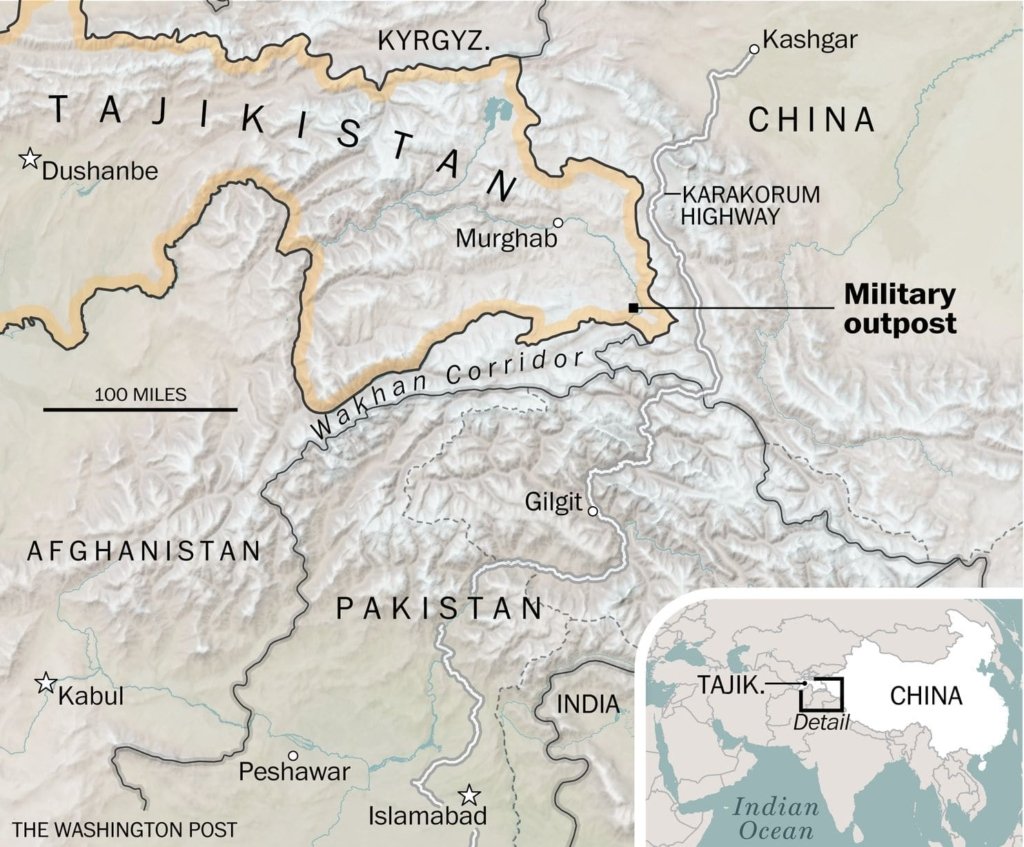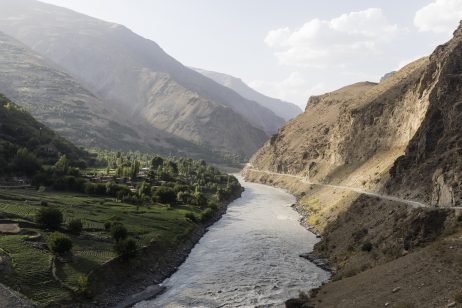Beijing’s security presence in Central Asia grows
DUSHANBE: Tajikistan has approved the construction of a new Chinese-funded base near the country’s border with Afghanistan as Tajik officials warn of growing threats emanating from its southern neighbour.
In a separate development, the Tajik government has offered to transfer full control of a preexisting Chinese military base in the country to Beijing and waive any future rent in exchange for military aid from China, according to a communique sent from the Chinese embassy in Dushanbe to Tajikistan’s foreign ministry.
The two developments paint a picture of a growing Chinese military footprint in the Central Asian country as Beijing and its neighbours in the region turn their attention toward an increasingly tenuous security situation in Afghanistan since the Taliban’s mid-August takeover.
“This decision to build such a facility is one of only a few known examples for China around the world,” Raffaello Pantucci, a senior associate fellow at London’s Royal United Services Institute, told RFE/RL. “The fact that we keep seeing this activity in Tajikistan shows the level of Chinese concern towards Afghanistan and the region.”

China already operates a military base in Tajikistan in the Murghab region near the Afghan border in a remote stretch close to the Wakhan Corridor. The collection of facilities and outposts is believed to have been in operation for at least five years and was the subject of a recent investigation by RFE/RL that showed Chinese personnel taking on a growing role in the area.
Both the Chinese and Tajik governments have officially denied the base’s existence and few details about its ownership and operation are known. The documents seen by RFE/RL’s Tajik Service say that Chinese personnel are operating at the base in Tajikistan, but that it currently is owned by Dushanbe.
According to the documents, the proposal to transfer ownership of the base to China was presented by Tajik President Emomali Rahmon to Chinese Defense Minister Wei Fenghe when he visited the Tajik capital, Dushanbe, in July.
“This highlights how Central Asia is going to be a major focus of Chinese attention,” said Pantucci. “Going forward, Beijing may struggle to avoid getting itself entangled in regional security problems.”
The documents do not state if Beijing has agreed to the proposal put forward by the Tajik side, but they summarize an offer put forward by Rahmon in which China would provide increased funding to build up Tajik military points along the border with Afghanistan in exchange for Dushanbe transferring full control of the existing facilities to China and not charging any basing fees.
“For China, security on its border is crucial and is part of its core interests in Central Asia,” Temur Umarov, an expert on China in Central Asia at the Carnegie Moscow Center, told RFE/RL. “Expanding its security presence in Tajikistan is the most effective tool that it possesses right now.”
The construction of the new facility was approved in Tajikistan’s lower house of parliament on October 27 as lawmakers voted on the agreement reached between Tajikistan’s Interior Ministry and China’s Public Security Ministry.

Tajik First Deputy Interior Minister Abdurahmon Alamshozoda said the facility would be located in the village of Vakhon in the country’s remote Gorno-Badakhshan Autonomous Province and that the base would be owned by the country’s special forces that operate under the purview of the Interior Ministry. Lawmakers said regular Tajik troops would also be present at the facility.
Tajik lawmaker Tolibkhon Azimzoda said in parliament that the new base would be built with Chinese funding and that the total cost would be about $10 million, which he tied to a worsening security situation in Afghanistan since the Taliban toppled the Western-backed government.
Tajik officials say only Tajik troops will be stationed at the Chinese-funded base.
Azimzoda told RFE/RL’s Tajik Service that Chinese personnel would not be stationed at the new facility.
“The construction comes amid the Taliban’s takeover of Afghanistan and growing security threats along the country’s border,” Azimzoda said.
Lawmakers said it would carry out policing duties focused on combating organized crime and that the facility would have “special equipment for the Interpol information system” installed from China.
Beijing is navigating a delicate security situation in the region since the Taliban takeover. China has a pragmatic working relationship with the group, but it remains to be seen how closely the Taliban will cooperate on counterterrorism issues with Chinese authorities.
For years, China has sounded the alarm about Uyghur extremists potentially using Afghanistan as a staging ground for attacks on Chinese targets in the region or in its western Xinjiang Province.
While the full scope of the threat posed by Uyghur militants is disputed, with many analysts saying the fighters lack coordination and numbers to launch attacks, the prospect of terrorist threats spreading from Afghanistan are a central concern for Chinese policymakers.
“Developments like this were coming, but the instability in Afghanistan has accelerated things,” Umarov said. “In the future, we might see Chinese military and intelligence cooperation intensify across the region.”
Much remains unclear, particularly with regard to what Chinese and Chinese-built security infrastructure already exist in Tajikistan, but also about the latest developments. At the same time, any and all movement in this space draws considerable attention not just in the region but from further abroad, says The Independent newspaper.

Between these two reports, on October 14, RFE/RL’s Tajik Service and Reid Standish reported on an apparent facility near Shaymak, a village in Murghab district, using satellite imagery and on-the-ground sources. Their article was an update on a 2019 Washington Post report, which claimed that Chinese troops had been in the area since at least 2016. The 2019 Washington Post report noted that the Chinese forces present appeared to be from the People’s Armed Police (PAP) rather than the People’s Liberation Army (PLA). The October 14 RFE/RL report cited locals who had visited the facility as saying that before the fall of the Western-backed Afghan government in mid-August, there had been Chinese, Tajik, and Afghan forces at the facility. Now, the Afghans are gone and given tensions between the Tajik government and the Taliban, it seems unlikely they would return any time soon.
Dushanbe and Beijing have consistently denied the existence of the Shaymak facility, although satellite imagery shows new facilities constructed next to an old Soviet base. The area is close to the tri-border shared between China’s Xinjiang, Afghanistan’s Wakhan, and Tajikistan’s GBAO.
China’s initial interests — as the October 14 RFE/RL report explained in detail — stem from a combination of protecting its Belt and Road Initiative in the Central Asian region and beefing up security in Xinjiang. It also fits into a narrative of steady expansion, with new facilities and reports back in 2019 of agreements for Chinese assistance in expanding existing border security facilities in Tajikistan.
The Taliban return to power in Afghanistan was taken in stride by Chinese officials, who elicited promises from the Taliban to not allow Afghan soil to be used by those threatening China, particularly Uyghur extremists. Even back in 2015, the Afghan government under Ashraf Ghani sought Chinese help in getting Pakistan to push the Taliban to the negotiation table in part by turning over Uyghur militants. Six years later, Beijing is singing the same tune.
Get briefed on the story of the week, and develop stories to watch across the Asia-Pacific. Despite China’s denials related to specific facilities, it’s clear that Beijing has continued to engage with Tajikistan on security matters. That Tajik officials are being (relatively) more transparent about the new facility is worth remarking on — as is their stressing of the Tajik nature of the facility. At the same time, China spending $8.5 million to construct a security outpost for Tajik use isn’t just out of the goodness of Beijing’s heart. Ishkashim district is at the other end of the Wakhan corridor from the previously reported facility near Shaymak and illustrates the growth of Chinese security infrastructure in the region.–RFE/RL/TheIndependent

